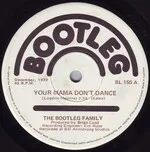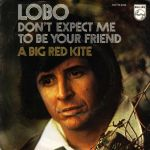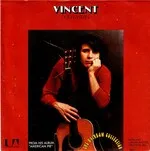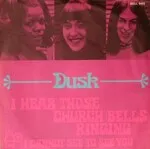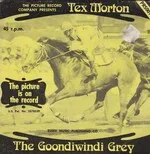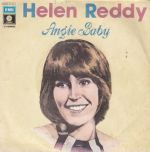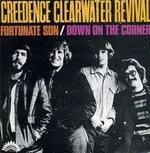I've decided to show what was popular during the waning years of the go set charts in Australia, although again I haven't included any commentary here as I feel uncomfortable with talking about songs that I struggle to form opinion about while also feeling that talking about the select few that I do have strong feelings about would reveal my biases in a negative way on this site. I'll also include stats from the last quarter of 1974 to evenly round out this list even though I'm obviously using AMR stats for those entries.
Well, I guess calling yourself a Bootleg band is one way to let people know you're nothing but a covers band cashing in off the success of much more famous bands and artists, here was the first of their two hits in Australia which came at the expense of the original from Loggins and Messina. At least their other big hit was a cover of a song from a decade prior.
#44 for 1973 (#50 AMR)
We have another entry from the debut album of Daddy cool on this list, this was the second single from said album which was released around the time the album dropped around the time the album was released in order to cash in off said albums success. It wasn't as inescapable as their earlier entry on this list, hence why you don't hear it much on oldies stations.
#38 for 1971 (#47 AMR)
This was the other hit that Vicki Lawrence had here in Australia, again it was far more a success with us Aussies than it was with her fellow Americans, suggesting that it was a hit here due to a tour she had rather than her involvement with the Mary Tyler Moore show.
#47 for 1974 (#43 AMR)
If it wasn't for "Say you'll stay until tomorrow" from later in the decade as well as his revival period in the 90's, this would've been the final hit in Tom Jones's career worldwide given how his popularity seemed to fall off a cliff despite ending the 60's on a high note with a highly successful live album based on a Vegas show of his.
#39 for 1971 (#37 AMR)
This was the only hit that South African singer John Kongos had in his career (side note this was an excellent time for African artists if this list is any indication) it's a song that's since been eclipsed here in Australia due to the Party boys cover from 1987. It's a song that's best known for its strong African style production from the drums to it having somewhat of a tribal ambience to it.
#40 for 1971 (#38 AMR)
We haven't had many musicians of colour on this list so far, let's change that by featuring the final hit from 5th dimension which was a huge success for them here in Australia as it was in their native America. I will say that these guys did quite well for themselves with us Aussies throughout their career given how they scored a few hits in the 60's in addition to this late entry from their catalogue down under.
#46 for 1972 (#49 AMR)
We looked at the big hit these guys had as Drummond earlier on this list, time now to look at their other big hit they had once they rebranded themselves as Mississippi a year after that big hit. From what I can gather, this is an original track from the band which meant that there was appeal for their original music as opposed to many of their contemporaries from this list alone.
#47 for 1972 (#54 AMR)
Even though Kevin Johnson is an Australian country singer and that his one and only hit was far from the most successful here in Australia upon its initial release, this somehow managed to become a minor international hit for him likely due to being based in the UK when he released it as a single.
#45 for 1973 (#68 AMR)
It took him a while to release a new album following the demise of his band Simon and Garfunkel, however Paul Simon found instant success once he did release new music on his own given how much of an instant success said album and its lead single was throughout the world. True to the title, this is a song about a mother reuniting with her son after a long time apart which naturally connected with audiences.
#48 for 1972 (#60 AMR)
Bobby Goldsboro is a country singer whose best known for his 1968 hit "Honey" which was a massive chart topper throughout the world that year including here in Australia. Fast forward five years and he managed to escape the one hit wonder bin with this ballad about the summertime albeit only here in Australia and the UK of all places.
#46 for 1973 (#55 AMR)
This is the most recent entry from the king of rock and roll on this list, although he did continue to find success during the second half of the decade right up until his untimely death in 1977.
#47 for 1973 (#67 AMR)
This was a moderate hit in Gary and Dave's native Canada from the previous year, indeed it took quite a while for it to crossover here in Australia as it was released at the start of the year to deafening silence only for it to gain popularity towards the end of the year. As it turns out, the two men were also aviators which would explain why they didn't have another hit in their career.
#48 for 1974 (#49 AMR)
While this wasn't meant to be used as an anthem for unionisation, the fact that this folk-rock track has such an anthemic chorus with the subject matter has since made it a popular choice for union protests over the years. It was the Strawbs only hit here in Australia and their native UK, although that might be due to the rest of their catalogue being more in line with prog rock which typically didn't spawn many hit singles.
#48 for 1973 (#47 AMR)
Named after the famous American settler, Daniel Boone (real name Peter Green) scored a huge international success with this track that seems to replicate the relaxed vibes of "In the summertime" from earlier on this list. Although this was his only hit in most parts of the world (including his native UK) he was quite popular in NZ with several of his other tracks around this time.
#49 for 1972 (#68 AMR)
This feels like a sequel to Lobo's earlier entry on this list, naturally this made it the perfect follow up to "I'd love you to want me" which is perhaps why it did so well internationally for the American singer/songwriter. It would be his final hit worldwide likely due to cheesy ballads like this falling out of vogue as the decade moved along.
#49 for 1973 (#44 AMR)
Well, we looked at their big hit they had here exclusively in Australia, time now to look at the big hit these guys had internationally which curiously had a bit of a delay to its success here as it only peaked in the early months of 1973 as opposed to Christmas 1972 like it did in NZ. Again, we have an instrumental track on this list, proving how popular this genre of music was around this time.
#50 for 1973 (#41 AMR)
This guy isn't the bassist for Queen despite them sharing the same name, instead he was an Australia TV composer who scored his one and only hit for the TV show Rush which was a popular Australian crime show from the 70's that was remade in the late 00's. From what I can gather, it was the Magnum P.I of its time, making this another occasion that American media stole from Australian media throughout history.
#49 for 1974 (#50 AMR)
This was originally an instrumental theme for the Hollywood blockbuster Love story; however, it was turned into a love ballad at the last minute when the producers decided to recruit American crooner Andy Williams to sing over the instrumental theme in order to score a hit for the film's soundtrack. This gambit paid off here in Australia where it was a huge hit, not so much anywhere else in the world where it wasn't.
#41 for 1971 (#41 AMR)
From what I can gather, this song was released internationally purely thanks to the success of Shocking blue's earlier entry on this list given how Tee set was another band from the Netherlands to find success at the start of the decade worldwide. It's even in the same genre which further links these guys to the geniuses behind "Venus," although sadly there's no 80's cover of this song like that track has.
#50 for 1970 (#44 AMR)
This was originally released in 1967 as the third single from Procol harum's debut album albeit only here in Australia, I guess we Aussies weren't that thrilled at having an exclusive track from these guys despite giving them two hits in the form of "A whiter shade of pale" and "Homburg" that year. It was given a second chance as a live track where it became a massive success worldwide.
#50 for 1972 (#57 AMR)
This was the second single to come from George Harrison's double album All things must pass, it was a massive hit for the former Beatle worldwide even with the strong album sales somewhat hampering its success in countries such as Australia which consist of data based on capitalism. This continues the spiritual theme of his earlier entry on this list which is a theme present throughout the album.
#42 for 1971 (#46 AMR)
We have another two for one entry on this list, although this time we're looking at a song that's already appeared on my site given how "Castles in the air" became a hit on its own a decade after this was released. "Vincent" was the main reason for this entries success due to it feeling like a John Denver track, particularly with the opening lyrics being "starry starry night."
#51 for 1972 (#52 AMR)
This has a bit of a weird story to its success, namely that despite being a real band, Kincade didn't exist when their debut single was released as it was merely the stage name of their frontman John Carter when it came to be. It was a surprise hit here in Australia as well as in certain parts of the world despite it failing to chart in their native UK.
#51 for 1973 (#54 AMR)
This was the final hit for Tommy Roe anywhere in the world, although this was another 60's carryover so it's tough to say if this was a last hurrah for the previous decade that just took too long to take off or if there was genuine interest for keeping this guy around in the 70's that was quickly discarded. Either way, it's a good representation of his bubble-gum pop sound as well as a bad representation of his early rockabilly sound.
#51 for 1970 (#65 AMR)
This is the first of two entries to come from the Kinks, it remains as their final hit single in most parts of the world due to the 60's band struggling to carryover their success into the 70's likely due to their two hits from the start of the decade being very different to the garage rock of their earlier material. It could also be that there's more of a novelty both of these tracks have compared to their earlier work lyrically.
#43 for 1971 (#50 AMR)
This was a surprise hit for Rick Nelson (formerly Ricky Nelson) given how this is actually about how he had faded into irrelevancy since his heyday as a teen idol from the 50's and early 60's. I guess we Aussies and his fellow Americans felt pity for his career trajectory (particular him getting booed while on stage) which is how this managed to become a huge hit for the former teen idol.
#52 for 1972 (#50 AMR)
It took us a while to get to a second hit from the Rolling stones on this track, however we finally have one with this lead single to their album Sticky fingers which was a much bigger hit in America and in their native UK likely due to strong album sales eating up its success here in Australia. This is their last entry on this site of mine as they only had three hits in the 70's down under (their two entries on this list and "Miss you.")
#44 for 1971 (#49 AMR)
Neil Diamond was on a roll when he released this single from his album Moods, it was his second Billboard chart topper proving how popular he was in his homeland as well as it being a huge hit internationally thanks to how in vogue his brand of soft rock was with the times.
#53 for 1972 (#44 AMR)
If you didn't know, Cher is in fact biracial or as she puts it, a half breed (half Native American and half Italian to be precise.) I guess this was a strong enough premise for her second Billboard chart topper as a solo artist given how the song is about how both sides of her family rejected her very existence due to the nature she was conceived (which she doesn't go into detail about as it's NSFW.)
#52 for 1973 (#56 AMR)
This was a big hit for American soft rock band the Gallery here in Australia as well as their native America and interestingly enough, Canada where it was a huge chart topper for them. Despite its international success, it remains their only hit worldwide given how the band only lasted a few years together before calling it quits in 1974.
#54 for 1972 (#48 AMR)
This was the first song that Diana Ross released following her acting debut in the Billie Holliday biopic the Lady sings the blues which she received an Oscar nomination for, naturally this song was guaranteed success given how that film was able to remind audience of her phenomenal talent as a vocalist given how well received her performance of Billie was both as an actress and singer.
#53 for 1973 (#48 AMR)
This was the first solo single that Ringo Starr released in his career, naturally it was an immediate success for the drummer of the fab four given how his former bandmates had dominated the charts with their earlier entries on this list following their breakup from the start of the decade. His true peak in success would come with his second solo album which contains his other two entries on this list.
#45 for 1971 (#45 AMR)
Shortly before she had most of her success stolen by Liv Maessen with her earlier entry on this list, Mary Hopkin managed to begin the decade with this track that does a great job in showcasing her abilities as a vocalist as well as bringing to life songs that were discarded by the members of the Beatles for whatever reason. It's a shame that her popularity died out after the first year of the decade came to an end.
#52 for 1970 (#55 AMR)
One of the stranger songs to become a hit throughout the 70's, we have this signature track from Three dog night which was by far their biggest hit both here in Australia and in their native America where it topped the Billboard charts due to how energetic it is. For whatever reason, Mariah Carey interpolated parts of this track for her cover of the Christmas hymn of the same name for her 1994 Christmas album.
#46 for 1971 (#53 AMR)
This guy was a frequent collaborator of Jigsaw back in the day, so it's interesting to note that his biggest hit was a solo entry that wasn't a cover of a more popular track (at least that I'm aware of.) He's also another pop crooner who dabbled as a TV presenter back in the day, a fairly standard practice for Australian male musicians it seems.
#54 for 1973 (#51 AMR)
This was the second big hit that Axiom had during their brief time together, I forgot to mention earlier that "Arkansas grass" was a carryover from the 60's, meaning that they were another band that began the 70's in the top ten that fell off fairly early into the decade.
#53 for 1970 (#46 AMR)
This was the only hit that Robin Jolley managed to score in his music career, although like many Australian pop crooners, he found more success as a TV presenter which seems to be how the music industry worked here in Australia back in the day.
#55 for 1972 (#51 AMR)
This was the first of three hits that Michael Nesmith scored here in Australia throughout the 70's, it's worth noting that although he was popular as a member of the Monkees, he never found much success in his native America likely due to his solo outing being considering "real" music compared to the prepackaged music he made for the TV show.
#54 for 1970 (#40 AMR)
Russell Morris was another Australia artist who began the 70's on a high note given how he came out of the 60's with not one but two chart toppers under his belt (those being "The real thing" and "Part 3 into paper walls.") That said, this was his biggest hit throughout the decade which was a far cry commercially from what he achieved with his earlier work.
#47 for 1971 (#40 AMR)
This was the first song that Elvis Presley released this decade, naturally it was a hit here in Australia given that it followed up "Suspicious minds" which remains one of his most iconic hit singles in his catalogue.
#55 for 1970 (#51 AMR)
If you're wondering how Murray Head could score a hit single in the mid 80's when he was pushing forty, that might be due to there being enough fondness for his first big hit from fifteen years prior which he recorded for the Jesus Christ superstar soundtrack (despite this version not making it onto the album.) It was a massive success in the southern hemisphere and even a minor success on Billboard.
#56 for 1970 (#63 AMR)
This was Dave Edmunds second hit here in Australia, although from what I can gather it's an Australian exclusive single given how it didn't appear to chart anywhere else int he world. I would've thought that it would at least touch the Billboard charts given how America seems to be the promised land in question going by the lyrics, however it was only us Aussies that appreciated this folk ballad.
#56 for 1972 (#47 AMR)
This was the only hit that Blue mink had in Australia, likely due to it being a plea for world peace given how the titled the track after the phrase "melting pot of friendship." They were far more successful in their native UK as well as NZ likely due to them having a woman of colour as their main vocalist in a band otherwise consisting of white men, a lineup that helped them stand out from the crowd back in the day.
#57 for 1970 (#54 AMR)
By far one of their most easily recognisable hits in their catalogue, we have this ballad from the Carpenters which became their biggest hit in the UK likely due to how tender it sounds despite it clearly being about nostalgia for the years that had gone by. It was also a huge hit in their native America, although not quite at the dizzying heights of their earlier entries.
#55 for 1973 (#77 AMR)
Well, the Osmonds might not have had any success here in Australia, however the same can't be said for their Canadian knockoff the Defranco family who managed to score a huge hit with their debut single as well as in America and their homeland. Basically, we have a rip-off of a rip-off here as the Osmonds are widely considered to be a knockoff of the Jackson 5 (who we'll thankfully get to eventually.)
#50 for 1974 (#59 AMR)
I bet you were beginning to think I forgot all about these guys given how long it's been since we looked at one of their many knockoffs throughout this list, it's almost a cruel joke that the Jackson 5 only has one entry on this list given how inescapable they were throughout the first half of the decade worldwide. At least MJ scored a massive chart topper here in Australia with his earlier entry on this list.
#58 for 1970 (#87 AMR)
We have another solo entry from Donny Osmond on this list, he was just racking up the hits here in Australia back in the day which is odd because the rest of his family didn't see this level of success (except Jimmy and maybe Marie with an entry we'll get to.)
#57 for 1972 (#75 AMR)
Barry Crocker is perhaps the most well-known pop crooner turned TV presenter in Australian music history, not for his music career but rather for how well known he is as a presenter. This was his only hit as a singer which was one of many entries on this list that has largely been lost to the sands of time over the years.
#56 for 1973 (#65 AMR)
This is by far the biggest hit that Charlie Rich had throughout the world, although this wasn't the case in NZ given how this bombed on the Listener charts and that "On my knees" from later in the decade was his big hit over there. I guess the kiwis weren't that into country music like the rest of the world was given how few of these country entries were a success on those charts.
#51 for 1974 (#56 AMR)
We've already looked at this song on the NZ side of my site when it was rereleased in the early 90's due to it being featured in a jean commercial in the UK, time now to look at its original release where it became the big breakthrough for the Steve Miller band due to it topping the Billboard charts for them. It was a huge hit here in Australia as well, hence why it managed to appear on this list of mine.
#52 for 1974 (#61 AMR)
Linda George is best known for her role as the acid queen in the theatrical adaptation of the Who's concept album Tommy, however she also had a hit this year as Miss Linda George (back when underage performers were referred to as Miss or Little) that became a hit for her this year. She mostly stuck to theatre after she became a one hit wonder, as did most female artists from the pre-Countdown era.
#53 for 1974 (#53 AMR)
This is the second rendition of the Christian hymn to make this list, although at least this one is a more conventional cover of the hymn as opposed to it being an (in my opinion) bizarre instrumental rendition played on bagpipes. Judy already appeared on my site with her rendition of "Send in the clown," meaning she wasn't a one hit wonder with us Aussies throughout the decade.
#48 for 1971 (#65 (AMR)
This was the second hit that John Lennon had with the Plastic Ono band, the first being "Give peace a chance" from the end of the previous decade which helped put Yoko Ono and her band on the map due to its success. There's speculation that Yoko was responsible for breaking up the Beatles due to her music receiving backlash over the years, the real reason for their breakup was due to John mistreating everyone in his life at the time.
#59 for 1970 (#62 AMR)
This was the big breakthrough hit that Bread had in their career, it's easy to see this as their debut single but it wasn't as they had a few failed releases in their native America in the 60's before making it big with this ballad. It was a huge chart topper for them on Billboard, which ensured its success throughout the rest of the world.
#60 for 1970 (#64 AMR)
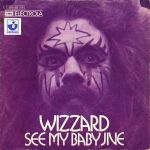
If this sounds like an ELO track to you, then you're not far off as several members of this band would go on to be a part of that band later in the decade. This also has members of the Move who were a 60's band that was a part of the psychedelia movement which explains those elements on this track. This was their only hit here in Australia, however they were quite popular in their native UK this decade.
#57 for 1973 (#49 AMR)
We have one final appearance from Neil Diamond on this list, it's another big worldwide hit he had proving yet again that he was on top of the world during the first half of the decade regardless of where you're from.
#49 for 1971 (#76 AMR)
On the surface, this seemed like a typical blues act that scored their one and only hit with this track before fading into obscurity. What's interesting about this track is the "friends" that provided backup vocals to the track, these friends include the likes of the Allman brothers, Eric Clapton, George Harrison, Leon Russell and Rita Coolidge, all of whom went on to have massive worldwide success following their appearance on this track.
#50 for 1971 (#89 AMR)
The best way to describe Lynsey de Paul is if Olivia Newton John began her career as a country artist whilst also having her sexual appeal she acquired from the Grease soundtrack, at least that's how I'd describe her one and only hit she had here and in her native UK with this entry.
#58 for 1972 (#56 AMR)
This is the earliest entry from Sherbet to feature on my site, naturally it was the song that finally caught the mainstream's attention of their work after several minor hits that failed to put them on the level of many other bands that have appeared on this list.
#58 for 1973 (#64 AMR)
This was the only hit for Australian country singer Reg Lindsay, it was a song written about Neil Armstrong following his overnight fame of being involved with the moon landing a year prior to this song's release. Apparently, he had tried to find success for over a decade by the time he released this track, proving how hard it's always been for Australian country singers in our music landscape.
#51 for 1971 (#58 AMR)
Although Tin tin was a duo from Australia, it took a year for this song of theirs to become a success here likely due to them releasing it in the UK to deafening silence and not releasing it here around the same time for whatever reason. Honestly the story behind the song is more interesting than the song itself as it's your typical bubble-gum pop track that history has long forgotten about.
#52 for 1971 (#72 AMR)
This is another entry from the Partridge family on this list, making it the fourth appearance from the TV band so far and proving just how popular they were with Australian audiences.
#53 for 1971 (#75 AMR)
I get the feeling this song was originally meant for Elvis Presley due to the vocals heavily reminding me of the king of rock and roll on this track, it's instead the one and only hit from country legend Faron Young outside of his native America as this was a surprise hit both here and in the UK for him. Interestingly, this bombed on the Billboard charts, meaning I have no idea how we Aussies and Brits came across it.
#59 for 1972 (#61 AMR)
This is one of two hits that Badfinger managed to achieve here in Australia, we'll get to the other one in a bit but suffice to say, the Welsh band who gave us the original rendition of "Without you" was decently successful back in the day even if that success down under was pitiful compared to what they achieved throughout the rest of the world.
#60 for 1972 (#63 AMR)
I'm not sure what to feel about this signature track from Joni Mitchell having most of its success come from Australia back in the day, I guess it was a modest hit in the UK and her native Canada which would explain how we Aussies came across it in the first place. For a song that's quintessentially a hippy track, it's amazing how well it holds up all these years after DDT has been outlawed.
#61 for 1970 (#59 AMR)
This was a massive worldwide hit for the Canadian band Ocean, likely due to how unapologetically religious it is which connected with spiritual audiences back in the day. It appears there weren't many Aussies in that audience given how much less successful it was here compared to the rest of the world.
#54 for 1971 (#73 AMR)
John Denver had been active in the music industry for the better part of a decade at this point, sure he had success in his native America, but it was when this lead single to his album Back home again became a surprise success in the UK that he finally saw massive international success. The song has become a bit of a meme over the years due to how overdramatic the ballad has remained since its initial release.
#54 for 1974 (#57 AMR)
I bet you were beginning to wonder if these guys had any success on our charts back in the day given how long it's taken for me to feature one of their quintessential tracks. Suffice to say that this is the first of two entries on this list which became a success around the time of Jim Morrison's tragic death.
#55 for 1971 (#64 AMR)
Ever wanted to hear a comedy track about a dead skunk? Well, you're in luck as Loudon Wainwright wrote a song with that subject matter as a comedy track which helped him score his one and only hit here in Australia by us Aussies who found this tale rather amusing to listen to at the time.
#59 for 1973 (#76 AMR)
There was no shortage of underage performers who made it big in the 70's, our latest entry comes from the Moir sisters who were a family trio of young women who scored their one and only hit with a song they wrote. I guess the fact they wrote this did put them on a higher league than the likes of the Osmonds and the teen idols from the second half of the decade, although they sadly remain a one hit wonder regardless.
#55 for 1974 (#58 AMR)
Glen Campbell was on a roll during the first half of the decade given how this was another easy hit he had throughout the world, although curiously it wasn't a huge hit in his native America which was also the case for his other entries on this list.
#62 for 1970 (#66 AMR)
We have another appearance from the king of rock and roll for this list, I wish I could say something more interesting about these tracks of his, but they're honestly in one ear and out the other for me, proving that he could release anything at this point in his career and it would be a hit with us Aussies.
#63 for 1970 (#77 AMR)
Well, I did mention that this was a huge hit for Sherbet earlier in the year when we looked at their other big hit they had this year, so let's look at this title track to Sherbet's third album which indeed confirmed them as a household name a year after "Cassandra" from their previous album put them on the map. They did have minor success during the first half of the decade; however, this was where they made it big.
#56 for 1974 (#60 AMR)
This is the only notable hit that the British group Fortunes had here in Australia, although like many British bands back in the day, they were far more lucrative in their homeland than they were internationally as they scored a ton of hits in their homeland throughout the 60's.
#56 for 1971 (#71 AMR)
There was a good chance that reggae was going to be the genre of the 70's if this track from Bruce Ruffin is anything to go by, it was a big hit here in Australia and even decently successful in the UK for the Jamaican singer likely due to the ad libs that pepper the track as well as that admittedly catchy reggae groove it has going for it.
#60 for 1973 (#43 AMR)
Well, we had to get to this track eventually, this is yet another song on this list that has gone down in infamy due to the subject matter which depicts Ringo Starr "owning" a sixteen-year-old he has the hots for. This was originally a hit for Johnny Burnette in 1960 (the father of Rocky Burnette of "Tired of toeing the line" fame) who would tragically pass away four years after his version made it big.
#57 for 1974 (#54 AMR)
This was the biggest hit that the New seekers had in their native UK as well as in America, this is due to the song being sampled for a Coca-Cola add shortly after its release which boosted its popularity throughout the world. Naturally this add had no affect on the song's popularity here in Australia given how it was far from the most popular song of its day here.
#61 for 1972 (#72 AMR)
This is one of several hits that Elvis Presley had during the first half of the decade that time hasn't been particularly kind to, I feel this is due to hindsight following his death from later in the decade as he would often perform many of these songs at Vegas which was obviously not good for his wellbeing.
#64 for 1970 (#60 AMR)
From what I can gather, Johnny O'Keefe is the earliest Australian artist to find international success given how his cover of "Shout" from 1959 managed to become a big hit throughout the rest of the world. Just before he released that track, he released the original version of this track which bombed back in the day but was given a second chance in 1972 where it became his final hit.
#62 for 1972 (#59 AMR)
We've look at the Jason Donovan version of this ballad, time to look at Bobby Vinton's take on the Brian Hyland track from a decade prior which proved to be quite popular for the aging (former) teen pop crooner from the 50's. Bobby did have a massive hit a decade prior with "Roses are red" which many consider to be one of the worst songs of the 60's due to its cheesy lyrics.
#63 for 1972 (#37 AMR)
Long before she was an Oscar nominated actress in Hollywood, Bette Midler was a throwback performer who scored her first big hit with this cover of the Andrew sisters track from thirty years prior. It was equally as popular here in Australia as it was in her native America, likely due to nostalgia for music made during the height of WWII.
#61 for 1973 (#57 AMR)
This was the other big hit that Jamie Redfern had during his time on Young talent time, this being a cover of the Frankie Avalon track from the late 50's (with no relation to Shocking Blue's track of the same name on this list.) Jamie was another victim of the Countdown purge despite being an Australian artist, I guess this was due to him failing to appear on the show during its run.
#62 for 1973 (#60 AMR)
This is the only other hit that the Kinks had this decade in most parts of the world, it's also (to my knowledge) the earliest hit single about a trans woman given that the titular woman is described as such. This has led to a polarising reception of the song in recent years as it's both praised for being ahead of its time for humanising these individuals and criticised for not going far enough (the latter usually by "woke" individuals.)
#65 for 1970 (#61 AMR)
#57 for 1971 (#52 AMR)
There are two songs with this title that appear on this list, although this was by far the bigger of the two entries due to how well it did in America for Looking glass. I guess we Aussies weren't that keen on having a love ballad dedicated to a girl named Brandy be that successful given how low it appears on this list.
#64 for 1972 (#79 AMR)
We've looked at the second hit that James Taylor had here in Australia (at least as a solo artist) "Handy man," time now to look at the fire big hit he had which is of course his signature track that he released at the start of the decade. This was such an instant success for the folk singer that it boosted the popularity of the album it came from to the point where it became a best seller here.
#58 for 1971 (#48 AMR)
We have one final entry on this list that had its success partially eaten up here in Australia due to a local rendition stealing its thunder, this time we have Johnny O'Keefe and unknown singer Margaret McLaren to thank for why the original from Carly Simon and her (then) husband James Taylor didn't see the levels of success here they did internationally with this collaboration.
#58 for 1974 (#85 AMR)
This was the last solo hit that Neil Diamond had in Australia, although he continued to find massive success with his albums and even scored a hit with a duet with Barbra Streisand later in the decade. I guess Countdown prevented him from scoring any more hits here but allowed his popularity to flourish with his albums.
#59 for 1974 (#62 AMR)
This was the debut single for Tony Orlando and Dawn, a song that wants you to believe came from a real band judging by its cover art (much like "Knock three times" and its cover art from earlier) but instead was from the crooner and his two backup singers of colour like all the other tracks in their catalogue.
#66 for 1970 (#57 AMR)
This was the first of many hits that Slade would have in their career, it was their biggest hit here in Australia likely due to it not being included on any of their albums like some of their other entries on this list we'll get to in a bit. I'm not sure why they titled their earliest songs the way they did other than to offend the Grammar Nazis of the world, at least they stand out among other generic titles.
#65 for 1972 (#53 AMR)
Although we'll look at Danyel Gerard's version of this track much later on this list, this version from Matt Flinders proved to be the big hit here in Australia which makes this yet another example of a local artist stealing the success that an international artist would've otherwise had back in the day.
#59 for 1971 (#44 AMR)
It was surprisingly hard to research this track given how it and the band behind it has fallen into obscurity over the years. From what I can gather, Dusk was a trio who were formed to compete with Dawn commercially, they only seemed to have success in the southern hemisphere given how this was a big hit for the girls in both Australia and NZ.
#60 for 1971 (#62 AMR)
Now if you felt that the previous entries comprising of Australian artists stealing the success of an international song with their inferior covers was infuriating, allow me to present to you a band whose entire gimmick revolved around this practice known as Jigsaw. This was their biggest hit as the band took the Mouth and McNeal track and made it their own in lieu of that track becoming a success.
#66 for 1972 (#41 AMR)
This is one of two entries from Jamie Redfern to make the list, Jamie of course being best known for being the first breakout star on the TV series Young talent time which was similar to that of the Mickey mouse club for Australia when it came to breeding child stars in the entertainment industry. This is another two for one deal as this comes with "Rainbow on the river" (which I couldn't find album art for.)
#67 for 1972 (#58 AMR)
From what I can gather, Tex Morton was an aging NZ country singer who scored a surprise hit with this track about a horse here in Australia during the first half of the decade. The horse in question was one of the most valuable in horse racing (a sport which I'm heavily against) much like that of Phar lap.
#63 for 1973 (#62 AMR)
This was the big breakthrough hit that David Essex had in his career, it's a bit of a far cry from all the other songs we've featured so far on this list given how this feels more in line with the glam rock scene of when it was released rather than the more pop friendly tracks from the second half of the decade. Interestingly enough, it remains his only hit in America despite how much bigger his later catalogue was over this.
#60 for 1974 (#47 AMR)
While this wasn't his debut single, this was the song that put Elton John on the map given how it was a massive success in most parts of the world due to how sentimental it was compared to many of the other ballads on this list. He would continue to find success for the remainder of the twentieth century with his subsequent follow ups.
#61 for 1971 (#61 AMR)
This was a reggae track that became a success here in Australia due to its massive popularity in the UK of all places, I'm not sure why it took off over there other than the Brits always seeming to have a soft spot for reggae over the years. It was Dave and Ansell Collins only hit down under; however, they did score a second hit in the UK after this.
#62 for 1971 (#59 AMR)
This was written by Burt Bacharach during the height of the Civil rights movement, meaning that this is less about world peace and more about racial harmony (even though the two are of course interchangeable with each other.) Dionne Warwick's version is the most well-known, however it's this version from Tom Clay that managed to be a big hit back in the day, at least it was here in Australia.
#63 for 1971 (#55 AMR)
This was the second single from Elton John's album Don't shoot me I'm only the piano player, this is a more sombre ballad compared to "Crocodile rock" which I'm guessing was a reminder to his (then) older fans of his blues roots given how he had begun to dabble with glam rock around this time.
#64 for 1973 (#58 AMR)
Petula was one of the biggest names in music throughout the 60's, so it's not that surprising that she would have one hit final during the first half of the decade even if that hit was only as such here in Australia. It's worth noting that this likely appealed to us Aussies because of nostalgia of her work from the forties as a child star.
#65 for 1973 (#66 AMR)

